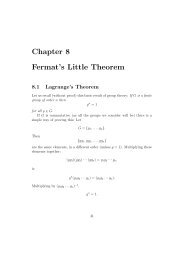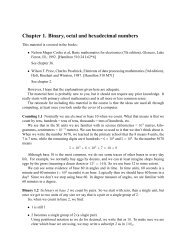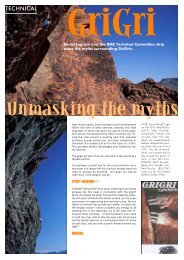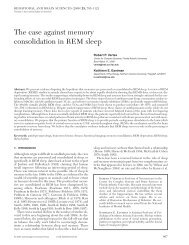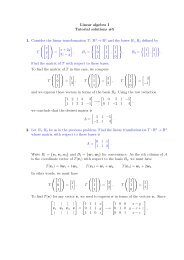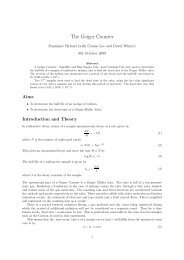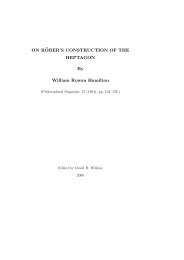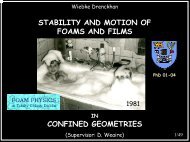Plasma
Plasma
Plasma
You also want an ePaper? Increase the reach of your titles
YUMPU automatically turns print PDFs into web optimized ePapers that Google loves.
⋆ Introduction<br />
<strong>Plasma</strong><br />
Gavin Cheung ⋆ 09328173<br />
January 27, 2012<br />
Abstract<br />
<strong>Plasma</strong>s have some unique properties compared to other states of matter.<br />
Using an argon filled tube along with the Child-Langmuir Law, the electron<br />
charge-to-mass ratio was found. It was found to be e = (1.323 ± 0.005) × 1012<br />
m<br />
C/kg which does not agree with the accepted value of 1.75 × 1011 C/kg. This<br />
suggests that the setup of the experiment may not agree with the assumptions<br />
of the Child-Langmuir Law. However, it was found that the ionisation<br />
potential of argon was 15 ± 1 V compared to the accepeted value of 15.7 V.<br />
A plasma was then created in a triode tube and a Langmuir probe was used to<br />
investigate its properties. The electron temperature of the plasma was found<br />
to be 0.7262 ± 0.002 eV agreeing with a result of Alexeff, Pytlinski and Olsen,<br />
0.9 eV. The electron density was found to be ne = 1.347 ± 0.002 × 108 cm−3 .<br />
Experiment 1: Measurement of e<br />
m<br />
884 Tube<br />
2<br />
3<br />
6.3 V ac<br />
7<br />
8<br />
5<br />
Heater Circuit<br />
and the ionisation potential of argon<br />
V<br />
mA<br />
Figure 1: Diagram of Circuit<br />
1<br />
22 Ohm<br />
B<br />
B = 0 - 35 V
A gas filled tube is a good way of creating a plasma. Consider a tube filled with argon with<br />
a cylindrical electrode structure as shown in figure 1. Consider a potential V across the plates.<br />
Due to cylindrical symmetry, Poisson’s equation is<br />
�<br />
1 d 1 d<br />
r dr r dr V<br />
�<br />
= − ρ<br />
where ρ is the charge density. Cylindrical symmetry also gives the current density to be J =<br />
2πrρv. If we assume that the electron’s energy is initially zero, then 1<br />
2 mv2 = eV . Combining<br />
these equations gives,<br />
It is found that this has solution<br />
r d2V dV<br />
+<br />
dr2 dr<br />
I =<br />
= J<br />
�<br />
2πɛ0( 4L<br />
9R )<br />
�<br />
2e<br />
m<br />
ɛ0<br />
� 2m<br />
eV<br />
�<br />
V 3<br />
2<br />
where L is the anode length (2.24cm) and R is the anode radius (0.15cm). This is the Child-<br />
Langmuir Law. It is easy to see that the electron charge-to-mass ratio can be found from this.<br />
However, for large voltages, the electrons have enough energy to ionise the argon and we can<br />
no longer assume the electrons do not interact with the gas. The current will deviate from the<br />
Child-Langmuir Law. Hence, it is possible to find the ionisation potential of argon by finding<br />
the difference between the breakdown voltage and the voltage at I = 0.<br />
Experiment 2: Measurement of the plasma electron density and electron temperature<br />
Langmuir Probe<br />
5<br />
B<br />
7<br />
V<br />
2<br />
Probe Current<br />
mA<br />
A<br />
Discharge<br />
Current<br />
470 Ohms<br />
Figure 2: Diagram of Circuit: A = 35 − 350V, B = 0 − 35V<br />
2<br />
mA
Consider now a gas triode as shown in figure 2. We create a plasma by applying a DC voltage<br />
between the cylindrical anode and ring cathode. The Langmuir probe is used to examine the<br />
properties of the plasma. Assuming that the electrons of the plasma have a Maxwell-Boltzmann<br />
distribution, then it is found that the current and voltage of the probe has the relation<br />
� �<br />
eV<br />
I ∝ exp<br />
kTe<br />
where k is Boltzmann’s constant and Te is the electron’s temperature. At higher voltages, the<br />
current will saturate at the point<br />
�<br />
kTe<br />
I = Anee<br />
2πm<br />
(1)<br />
where A is the surface area of the probe. In this experiment, the length is 5mm and the diameter is<br />
0.7mm. ne is the electron density. Our aim in this experiment is to find the electron temperature<br />
and the density of electrons.<br />
⋆ Experimental Method<br />
Experiment 1<br />
Set up the circuit as shown in figure 1. Allow the circuit to warm up. Measure the current whilst<br />
varying the voltage from 0 to 14V.<br />
Experiment 2<br />
Set up the circuit as shown in figure 2. Raise the discharge voltage until a purple glow is observed.<br />
Set the discharge voltage to some value such that the discharge current is about 10mA. Measure<br />
the probe current whilst varying the probe voltage from -4 to 15V.<br />
⋆ Results and Analysis<br />
Experiment 1<br />
From figure 3, the slope of the graph is m = 2.135 ± 0.008 V/mA 2/3 . Using the Child-Langmuir<br />
Law, it was found that e<br />
m = (1.323 ± 0.005) × 1012 C/kg. The accepted value is 1.75 × 10 11<br />
C/kg. This is out by an order of magnitude suggesting that there may be some unaccountable<br />
experimental error. It is also possible that the assumptions of the Child-Langmuir Law were not<br />
valid while this experiment was running such as the electrons having initial kinetic energy or<br />
the structure of the tube may not be perfectly cylindrical. It was also found that the ionisation<br />
potential of argon was 15 ± 1 V from reading the graph which agrees with the accepted value of<br />
15.7 V.<br />
3
Experiment 2<br />
V o lta g e (V )<br />
2 0<br />
1 9<br />
1 8<br />
1 7<br />
1 6<br />
1 5<br />
1 4<br />
1 3<br />
1 2<br />
1 1<br />
1 0<br />
9<br />
8<br />
7<br />
6<br />
5<br />
4<br />
3<br />
2<br />
1<br />
0<br />
0 2 4 6 8 1 0 1 2 1 4 1 6 1 8<br />
I^ 2 /3 (m A ^ 2 /3 )<br />
Figure 3: Graph of I 2<br />
3 vs V with m = 2.135 ± 0.008 V/mA 2/3<br />
The electron temperature is kTe = e . From figure 4, the slope is d = 1.377 ± 0.005 so the energy<br />
d<br />
of the electrons is kTe = 0.7262 ± 0.002 eV. This is close to the experiment done by Alexeff,<br />
Pytlinski and Olsen who got a value of 0.9 eV. The discrepancy is most likely because their<br />
setup was slightly different from our experiment. Te is found to be around 8000K. This may<br />
sound like a ridiculously high temperature. However, this is a unique consequence of plasma<br />
physics. The saturation current was found to be 5.92 ± 0.01 mA. Hence, it was found from<br />
equation (1) that ne = 1.347 ± 0.002 × 108 cm−3 . Comparing to Alexeff et al., their result was<br />
2.7 × 109 cm−3 . Taking into account that our setup was different, this is a reasonable result.<br />
⋆ Conclusion<br />
The electron charge-to-mass ratio was found to be e<br />
m = (1.323 ± 0.005) × 1012 C/kg which<br />
unfortunately does not agree with the accepted value of 1.75 × 10 11 C/kg implying there has<br />
been some unknown error in the experiment or our initial assumptions are invalid. It was found<br />
that the ionisation potential of argon was 15 ± 1 which agrees with the accepted value of 15.7 V.<br />
In the triode tube, the electron temperature was found to be 0.7262 ± 0.002 eV similar to a<br />
result of Alexeff, Pytlinski and Olsen. The electron density was found to be ne = 1.347 ± 0.002 ×<br />
10 8 cm −3 .<br />
4
⋆ References<br />
ln P ro b e C u rre n t (m A )<br />
4<br />
2<br />
0<br />
-2<br />
-4<br />
-6<br />
-8<br />
-5 0 5 1 0 1 5<br />
V o lta g e (V )<br />
Figure 4: Graph of V vs ln I with d = 1.377 ± 0.005mA<br />
Phys. Rev. 2, 450486 (1913); Irving Langmuir<br />
New elementary experiments in plasma physics; I. Alexeff, J. T. Pytlinski, N. L. Oleson<br />
5





